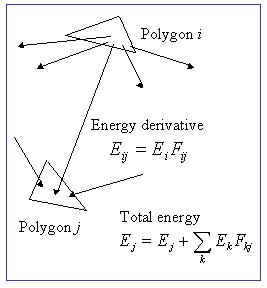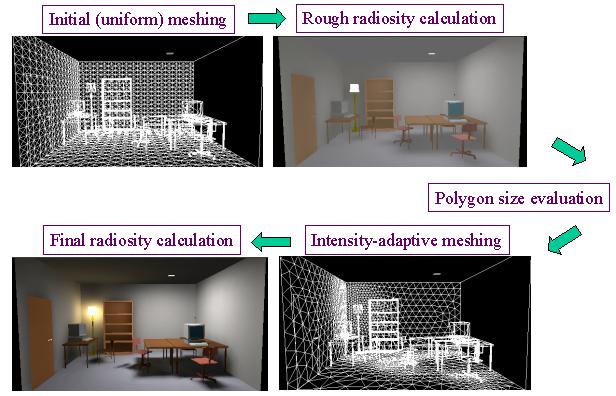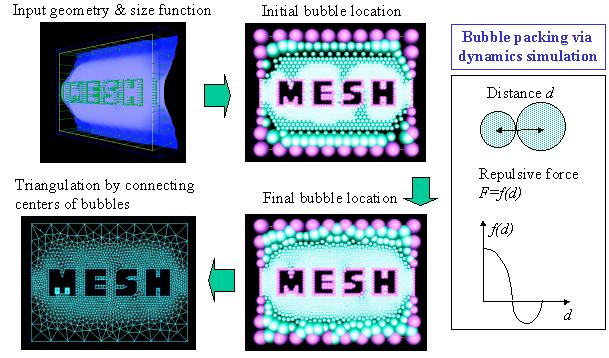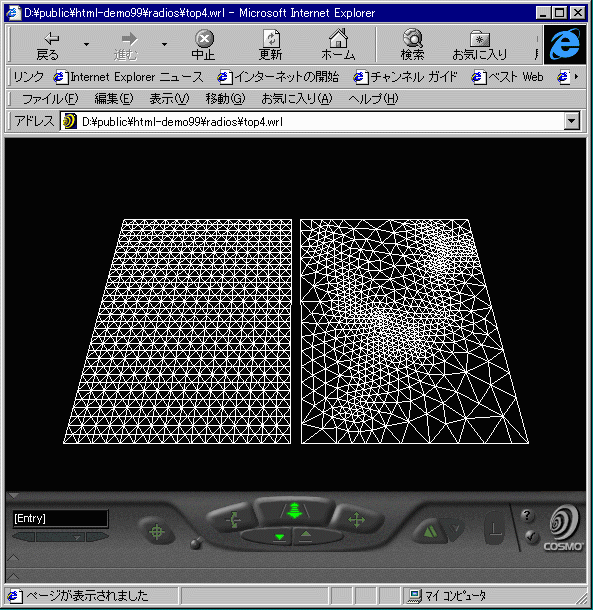
| Radiosity is a method for generating photo-realistic images. Given a set of polygosn, it calculates the light energy of each polygons in a scene. Photo-realistic images can be generated by providing the polygons with the intensity calculated by the ratiosity to conventional rendering methods, such as ray tracing method. |

|

| Radiosity method uses an energy equilibrium equation. Let Eij an energy that a polygon j receives from a polygon i. Eij is a part of Ei, the total energy radiated from the polygon i, and the ratio of Eij to Ei, Fij, is a constant value. The constant value Fij is often called "form factor". |
|
The energy of each polygon is calculated by solving the
equation shown in the right figure.
Here, accuracy of energy strongly depends on the sizes
of polygons. Of course, computation time and data size
also depends on their sizes.
In such cases, we often apply the adaptive meshing methods, that generate graded meshes. At the regions those intensity is sharply varied, such as shadow boundary or highlight, the smaller polygons are generated. Otherwise, the larger polygons are generated. |

|
|
The following figure represents a simple adaptive
meshing system for radiosity.
We developed such a system by applying the bubble mesh method.
Carefully compare the two meshes. Though often the quality of the adaptive meshes get poor, the triangular elements in the graded mesh (see the right-bottom figure) are still well-shaped. It is experimentally said that the generation of well-shaped polygons is desirable for avoiding the intensity error whole rendering. Element sizes of the graded mesh are larger than the those of the initial mesh in some regions, and smaller in other regions. This adaptive mesh simultaneously generates finer and coaser elements. The function is useful to control the trade-off between the quality and computation time. |

|
|
The bubble mesh method properly generates a set of vertices
of a triangular mesh.
The method assumes a circular particle model, that has
attractive and repulsive forces, like van del Waals model.
Given a scalar function that represents user-desired
element sizes, the method controls the radii of particles
according to the function.
Therefore the population of vertices of a mesh is controlled
by the function, and finally a graded triangular mesh is
generated by connecting the centers of the particles.
We implemented to generate such a scalar function, calculating from the difference of intensity between each element and its adjacent elements. |

|
|
The following animation has been demonstrated at SIGGRAPH '98. I do not think it is an amazing result :-) but helpful to explain the effort of adaptive meshing to non-expert persons. |

|
Since I have some ideas to try on this work.
However, my research environment has been moved to
Windows, and I have no time to port my radiosity
program from UNIX.
I am thinking of looking for a radiosity freeware
running on Windows ...
Related publications:
Itoh T. et al., Adaptive Meshing for Radiosity Using Bubble Mesh Method, IPSJ Graphics & CAD Technical Reports, Vol. 96-CG-81, pp.73-78, 1996. (written in Japanese)
TRL Meshing project in SIGGRAPH 1998 Exhibition,
http://www.trl.ibm.com/projects/meshing/sig98/sig98E.htm.